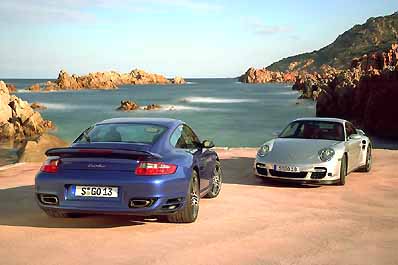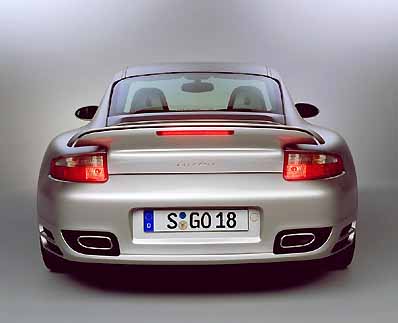

A characteristic
design feature of the new 911 Turbo is the modified front end with its
distinctive, tautly drawn cooling air inlets

Charakteristisches Designmerkmal des aktuellen
911 Turbo ist das neu geformte Bugteil mit seinen markanten, straff
ausmodellierten Kühllufteinlässen |
Porsche extends its range with a new 911 model
Stuttgart. Dr.
Ing. h.c. F. Porsche AG, Stuttgart, is extending its current product range
with the addition of a new 911 Turbo. The sixth generation of the 911 series'
top-of-the-range model will be celebrating its world premiere on February
28, 2006 at the Geneva Motor Show and will be available in German dealerships
as from June 24, 2006.
 The 911 Turbo (Type 997) now has an output of 353
kW (480 bhp) at 6,000 revolutions per minute, 60 bhp more than its predecessor
(Type 996). The specific output of the 3.6-litre boxer engine thus climbs
to a new all-time high of 98 kW (133 bhp) per liter of displacement. Rated
torque has been increased from 560 to 620 Newtonmeters. The speed range in
which this power is available has also been extended. While the previous
model's maxi-mum torque was available between 2,700 and 4,600 revolutions
per minute, the corresponding figures are now 1,950 to 5,000 revs. These
improvements are translated into driving performance. The new 911 Turbo with
six-speed manual transmission requires 3.9 seconds for the standard sprint
from zero to 100 km/h. The coupé reaches the 200 km/h mark in 12.8
seconds. And just 3.8 seconds are all it takes for the most powerful series-built
911 model of all time to accelerate from 80 to 120 km/h in fifth gear. Despite
these enhanced performance statistics, Porsche developers succeeded in reducing
average fuel consumption by one tenth to 12.8 liters per 100 kilometers.
The 911 Turbo with the optionally available Tiptronic S automatic transmission
puts in an even more impressive performance. An optimized setup gives the
vehicle the wherewithal to power from zero to one hundred in just 3.7 seconds
and to reach 200 km/h after a mere 12.2 seconds. The Turbo with automatic
transmission also has the advantage when it comes to flexibility. In penultimate
gear it accelerates from 80 auf 120 km/h in 3.5 seconds. Fuel consumption
by the Tiptronic S variant is 0.3 liters lower than that of its predecessor:
13.6 liters in accordance with the EU standard. Both transmission variants
have a top speed of 310 km/h. The 911 Turbo (Type 997) now has an output of 353
kW (480 bhp) at 6,000 revolutions per minute, 60 bhp more than its predecessor
(Type 996). The specific output of the 3.6-litre boxer engine thus climbs
to a new all-time high of 98 kW (133 bhp) per liter of displacement. Rated
torque has been increased from 560 to 620 Newtonmeters. The speed range in
which this power is available has also been extended. While the previous
model's maxi-mum torque was available between 2,700 and 4,600 revolutions
per minute, the corresponding figures are now 1,950 to 5,000 revs. These
improvements are translated into driving performance. The new 911 Turbo with
six-speed manual transmission requires 3.9 seconds for the standard sprint
from zero to 100 km/h. The coupé reaches the 200 km/h mark in 12.8
seconds. And just 3.8 seconds are all it takes for the most powerful series-built
911 model of all time to accelerate from 80 to 120 km/h in fifth gear. Despite
these enhanced performance statistics, Porsche developers succeeded in reducing
average fuel consumption by one tenth to 12.8 liters per 100 kilometers.
The 911 Turbo with the optionally available Tiptronic S automatic transmission
puts in an even more impressive performance. An optimized setup gives the
vehicle the wherewithal to power from zero to one hundred in just 3.7 seconds
and to reach 200 km/h after a mere 12.2 seconds. The Turbo with automatic
transmission also has the advantage when it comes to flexibility. In penultimate
gear it accelerates from 80 auf 120 km/h in 3.5 seconds. Fuel consumption
by the Tiptronic S variant is 0.3 liters lower than that of its predecessor:
13.6 liters in accordance with the EU standard. Both transmission variants
have a top speed of 310 km/h.
 The vehicle's flexibility can be enhanced even further
with the optional "Sport Chrono Package Turbo", available for the first time.
Here the driver selects the "sports button" adjacent to the gear lever to
activate a short-time "overboost" at full throttle. This increases boost
pressure in the mid speed range by 0.2 bar for up to ten seconds; torque
rises by 60 to 680 Newtonmeters. The time required by the 911 Turbo with
manual transmission for intermediate acceleration from 80 to 120 km/h is
reduced by 0.3 seconds to 3.5 seconds. These performance figures owe themselves
to exhaust turbochargers with variable turbine geometry, featuring for the
first time in a gasoline engine model. At the heart of this technology are
adjustable guide blades, which direct the engine exhaust flow variably and
precisely onto the turbine wheel of the exhaust turbocharger. The principle
of variable turbine geometry unites the advantages of small and large exhaust
turbochargers and leads to a discernable improvement in flexibility and
acceleration, particularly at low speeds. To transfer the available power
to the road, the new generation of the 911 Turbo features a redesigned all-wheel
drive with an electronically controlled multi-disc clutch. Porsche Traction
Management (PTM) ensures variable power distribution to the two driven axles.
Depending on the driving conditions, the all-wheel electronics system constantly
determine the optimal torque distribution to ensure the best-possible drive.
In practice this translates as high agility on narrow country roads, outstanding
traction in rain and snow and optimal active safety even at high speeds.
These properties make the Porsche Traction Management system in the new 911
Turbo one of the most powerful and, at the same time, lightest all-wheel
systems on the market. The new 911 Turbo's driving performance is duly tempered
by its brake system, which comprises monobloc fixed-caliper disc brakes with
six pistons at the front axle and four at the rear. The vehicle's flexibility can be enhanced even further
with the optional "Sport Chrono Package Turbo", available for the first time.
Here the driver selects the "sports button" adjacent to the gear lever to
activate a short-time "overboost" at full throttle. This increases boost
pressure in the mid speed range by 0.2 bar for up to ten seconds; torque
rises by 60 to 680 Newtonmeters. The time required by the 911 Turbo with
manual transmission for intermediate acceleration from 80 to 120 km/h is
reduced by 0.3 seconds to 3.5 seconds. These performance figures owe themselves
to exhaust turbochargers with variable turbine geometry, featuring for the
first time in a gasoline engine model. At the heart of this technology are
adjustable guide blades, which direct the engine exhaust flow variably and
precisely onto the turbine wheel of the exhaust turbocharger. The principle
of variable turbine geometry unites the advantages of small and large exhaust
turbochargers and leads to a discernable improvement in flexibility and
acceleration, particularly at low speeds. To transfer the available power
to the road, the new generation of the 911 Turbo features a redesigned all-wheel
drive with an electronically controlled multi-disc clutch. Porsche Traction
Management (PTM) ensures variable power distribution to the two driven axles.
Depending on the driving conditions, the all-wheel electronics system constantly
determine the optimal torque distribution to ensure the best-possible drive.
In practice this translates as high agility on narrow country roads, outstanding
traction in rain and snow and optimal active safety even at high speeds.
These properties make the Porsche Traction Management system in the new 911
Turbo one of the most powerful and, at the same time, lightest all-wheel
systems on the market. The new 911 Turbo's driving performance is duly tempered
by its brake system, which comprises monobloc fixed-caliper disc brakes with
six pistons at the front axle and four at the rear.
In comparison with the Type 996, the diameter of the internally ventilated
and perforated brake discs at the front and rear wheels has been increased
by 20 millimeters to 350 millimeters. As an option, Porsche is also offering
its optimized ceramic brake system, PCCB (Porsche Ceramic Composite Brake).
The advantages of this high-tech material mean a reduction of 17 kilograms
compared to the standard brake system, excellent fading stability owing to
consistent friction values and absolute corrosion resistance. The brakes
now have a diameter of 380 millimeters at the front axle and 350 millimeters
at the rear.
A characteristic design feature of the new 911 Turbo is the modified front
end with its distinctive, tautly drawn cooling air inlets. In conjunction
with the standard-equipment oval bi-xenon headlights, they define its
unmistakable image. The harmonious front view is enhanced by widely placed
and deep-set fog lights and by new LED flashers, which are situated in the
lateral air inlets of the front end. From the rear perspective too, the Turbo
takes on a more powerful appearance. This is due first and foremost to its
tail end, 22 millimeters wider than that of the previous model, to which
the redesigned wing spoiler element has been aligned. It now slopes downward
slightly at the sides to nestle into the contours of the rear fenders. The
lateral air inlets behind the doors have also been redrawn and, together
with the new air ducts, afford a more efficient supply of cooling air to
the charge-air intercoolers.
The basic Euro price for the 911 Turbo is 115,000 Euros. In Germany it is
available for 133,603 Euros including value added tax and country-specific
requirements. In the USA the 911 Turbo is priced at 122,900 Dollars (not
including taxes), and will be available as from July 8, 2006. In addition
to the 911 Turbo, as a special surprise at the Geneva Motor Show, Porsche
will be presenting another world premiere: the new 911 GT3.

| Porsche Press Information,
February 13, 2006 |
Back to
Top |